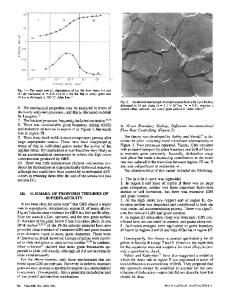Microstructural Aspects of High-Performance Cement-Based Materials
- PDF / 4,104,253 Bytes
- 10 Pages / 414.72 x 648 pts Page_size
- 41 Downloads / 333 Views
W. JIANG AND D.M. ROY The Pennsylvania State University, Materials Research Laboratory, University Park, PA 16802, U.S.A.
ABSTRACT The goal of this research is to improve the physical properties, mechanical properties and durability of cement-based materials by controlling chemistry and processing to produce the desired microstructures and properties. An accompanying initiative is to establish the basic scientific understanding relating processing and microstructure with physical and mechanical behavior, for the future development of new, special purpose, high performance cement-based materials. The research involves both experimentation and theory elucidating fundamental strengthening mechanisms for materials such as warm-pressed, MDF, DSP, polymer, and fiber composites. SEM and computer image analysis were used. Of interest are creating process models that serve as a basis for real applications such as in the following areas: High-performance highway concrete, and the immobilization of radioactive waste. INTRODUCTION The demand worldwide for high-performance cement-based materials has increased, and predictions are that it will reach a major industrial dimension by the year 20001. Problems encountered during development of high-performance cannot be solved by trial-and-error experiments, therefore it is imperative to understand the microstructure of such products and relate it to the engineering parameters. The key factor in bringing more new or enhanced highperformance cement-based products to fruition is understanding the fundamental microstructureproperty-performance relationship. The importance of establishing performance data bases and use criteria is paramount in the battle for survival of the one-third of America's infrastructure which is now classified by the federal government as deteriorated or deteriorating (The Washington Monthly, November, 1991). This research derives from the systematic research effort on cementitious material microstructure in which the Materials Research Laboratory at the Pennsylvania State University has been involved during the last decade. Although portland cement has been successfully adapted to produce concrete with high strength, it is generally not possible to make products free from defects2 . There are four major defects. High porosity - Cement-based material is a porous material. The reaction of cements with water leaves behind pores; the excess porosity non-bound water has detrimental effects on the strength and durability. Inhomogeneity - This could occur at both micro- and macro- level. The density varies by more than 10 percent from a mean value over dimensional ranges spanning from nanometers to millimeters. The pore size exhibits high gradients or changes in distribution within a specimen. In composites the aggregate/fiber/polymer are difficult to distribute. Honeycombing and segregation of concrete are often encountered due to the lack of consolidation or too much consolidation. Cracking- A crack or fissure at the surface or in the interior of a solid is a stress
Data Loading...











